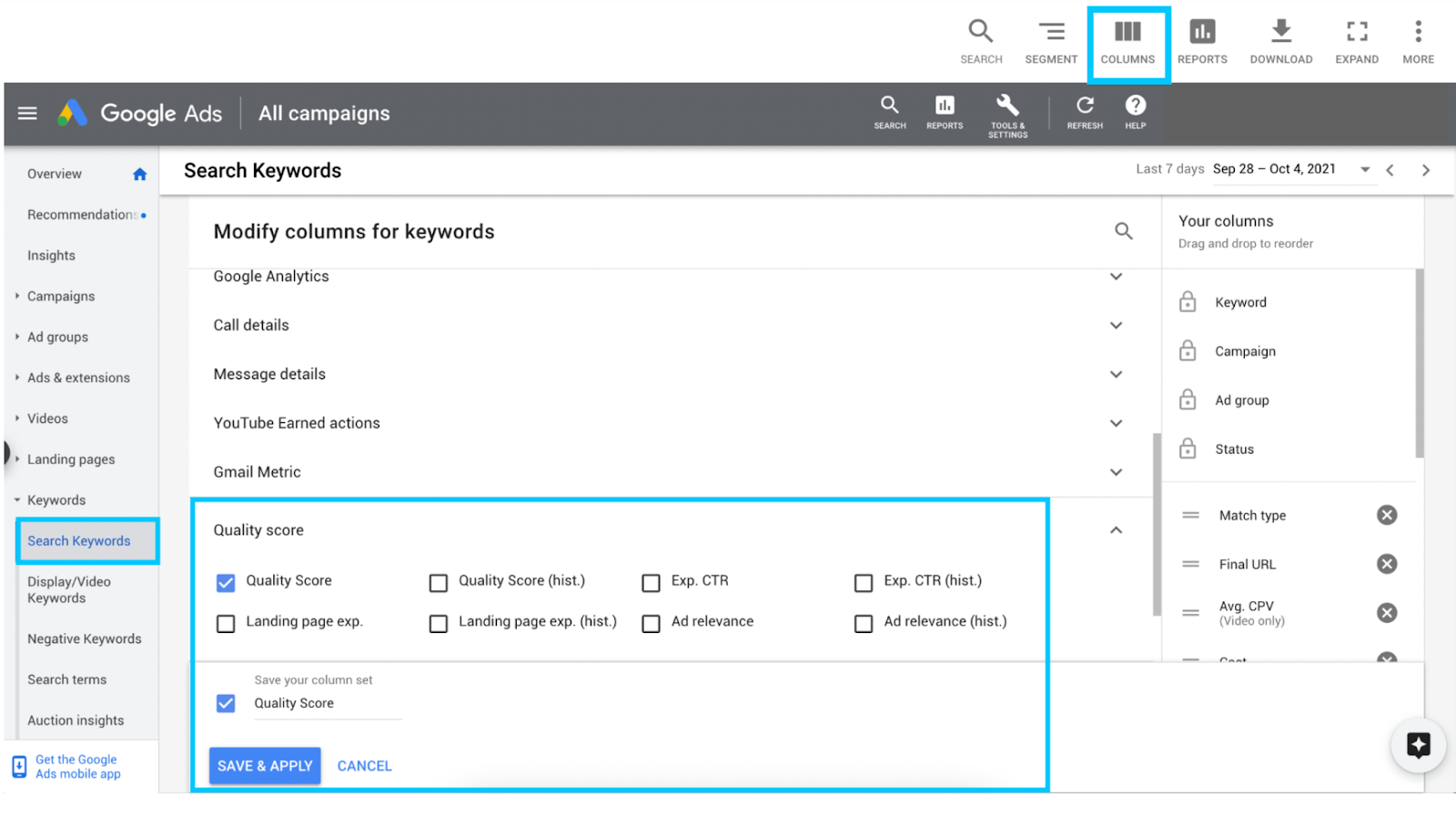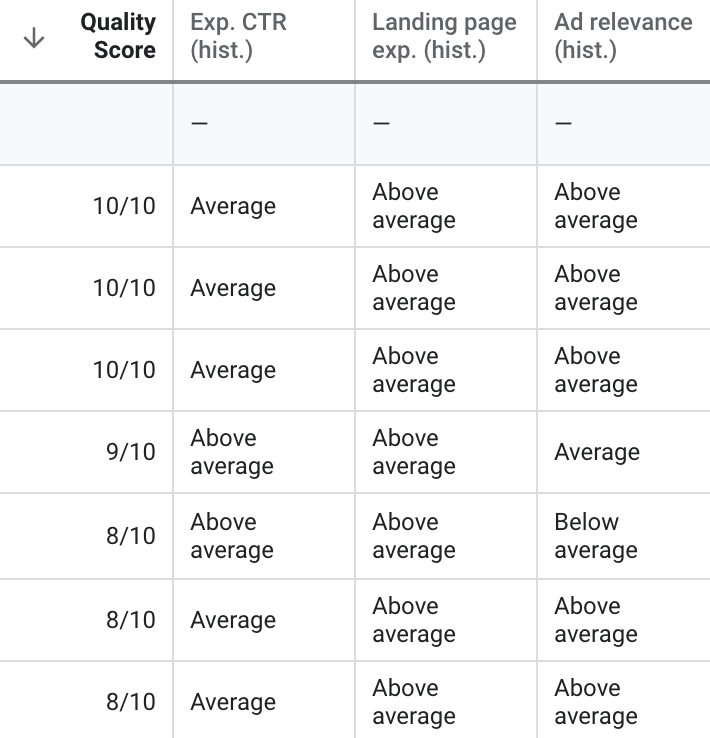Quality Score is a measure used by Google, Bing, and Yahoo! to access your ad quality in terms of matching the user's search intent. This is a score of 1 to 10, with 10 being the highest value. 3 components influence the Quality Score and cost per click.
In this article, you'll get to know why a Quality Score is important and the way it predetermines your CPC. We'll uncover 3 components of a Quality Score and share some tips to improve this measure.
Why is Quality Score important?
First and foremost, Quality Score is not a KPI but a diagnostic tool, as Google states. It helps you understand how users interact with the same keywords as yours. Your score identifies the relevancy of your ad compared to your competitors. The highest the score, the more useful is your ad or landing page to your target audience. Quality Score is assigned based on the ads analysis of other advertisers using the same keyword during the last 90 days.
Although Google Quality Score is not considered in the ad auction, it provides advertisers with several benefits. Firstly, this measure allows you to save your advertising budget. The higher your Quality Score, the less your will have to pay for your ad placement. Let's see how it works.
Google earns money on advertising, consequently, the search engine is paid only when users click the ads. To make them click through, ads should be relevant to their needs. If the advertising space was clogged in with irrelevant ads, users wouldn't click the links, and Google wouldn't make a profit. In the long run, this can lead to frustration and distrust of the search engine. This is why Google is interested in providing people with the best user experience.
Secondly, since the high Quality Score helps you save money, your cost per conversion lowers as well. As a result, you earn more money providing users with the relevant offers. Besides, along the way, you'll spend less on acquiring new customers.
Thirdly, the higher your Quality Score, the higher position your ad will occupy on the search engine results page (SERP). As a result, your CTR will boost as well. Before Google AdWords adopted the Quality Score, CTR was the main factor of ad relevancy.
Now that you're familiar with the benefits of high Quality Score, it's time to uncover its main components.
3 Components of Quality Score
There are 3 main components that influence your Quality Score. Сheck them out below.
- Expected CTR. This measure shows the likelihood that users will click your ad when shown.
- Ad relevance. This measure shows how well your ad matches the user's search intent.
- Landing page experience. This measure shows the relevancy of your landing page to users who clicked through your ad.
Besides these primary factors, there's a list of others that somehow affect your Quality Score. They include the following ones:
- user location;
- geographic performance of your ads;
- devices used;
- time of day;
- ad extensions.
In addition, Google takes into account any data aggregated from different crawlers to get a full picture of your ad quality. This information will never go outside of Google.
Now you might be interested in how to get to know your Quality Score. Stay tuned!
How to find your Quality Score?
To check your Quality Score, follow the instructions below.
Go to your Google Ads account.
Navigate to “Keywords”, select “Search Keywords”, and click the icon of Columns to customize them. To get the report, tick any components that you're interested in, for example, “Quality Score”, “Landing page exp”, “Ex CTR”, “Ad relevance”.

You will get this kind of report. Each component has its status: “Below average”, “Average”, “Above average”. If some statuses are average or below average, your ad needs improvements. You can get the hint by hovering over the status field.

You can also check historical values by choosing the corresponding metrics: Quality Score(hist.), Landing page exp. (hist.), Exp. CTR (hist.), Ad relevance (hist.). You will see your past reports for the necessary data ranges.
Segment by day to see daily changes. For this purpose, navigate to “Segment”, select “Time”, and click “Day”.

Now that you know what influences your ad quality score, it’s time to learn some tips to improve the measure.
How to improve your Google Quality Score?
Since ad CTR, relevance, and landing page experience contribute the most to your Quality Score, you should focus on improving these components. Follow the best practices below.
- Develop a granular structure of ad groups. To make users click your ad, it should match their intent. The more ad groups you create, the better their keywords will match the ads within one group. For example, if you sell clothing, avoid combining keywords with a different intent in one group. Users may want to order delivery, check your contact information, look for particular items, or visit a physical store. For each case, you should create a different ad group with different keywords.
- Write a relevant ad copy. Your task is to make your ad provide users with the solution they need. For this purpose, you can include your best keyword in the headline, URL, and ad text. This will signal both users and search engine robots that your offer is relevant to users’ needs. At the same time, make sure that your ad looks natural.
- Optimize your landing page. Firstly, choose the landing page most relevant to your ad and avoid directing users to your homepage. Make sure that this page provides the exact solution. For example, if your ad targets people who want to pick up the product, don’t provide a link to a page where they can order delivery. Secondly, make the user experience your top priority. Check if the landing page loads fast and whether it’s easy to interact with it from both a laptop and mobile.
- Make use of negative keywords. Each business knows about the keywords that look relevant but can confuse the users while searching. To save your advertising budget and target more precisely, create a list of negative keywords. It has no direct impact on your Quality Score but helps avoid lowering your CTR.
- Include ad extensions. They not only grab attention because occupy much space in the SERP but provide users with more useful information about your business. Ad extensions include callouts, sitelinks, call extensions, message extensions, structured snippets, rating, etc. They help blow up your CTR and provide users with a lot of data about your brand through an ad.
Congrats, now you know why a Quality Score is important and have some tips to increase this measure. Track your past quality scores regularly to improve the performance of your ads!
Last Updated: 22.03.2023

or